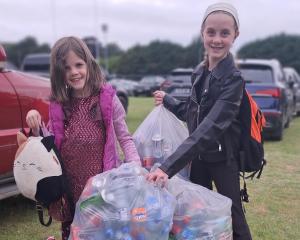
One of our exciting projects at Wastebusters this year has been helping to design and trial a new community-based food waste prevention programme called Every Bite. Wastebusters is one of four regional hubs developing the programme nationwide, with the goal of supporting our communities to reduce food waste.

You may have heard about the New Zealand research that found every household is throwing away more than $1500 worth of food on average a year. That’s equivalent to five average shops of groceries going straight in the bin, or enough money to pay for a pretty good holiday! And it’s not just the money - food production generates a third of climate emissions, more than global aviation. When we waste food, we waste all the associated climate emissions, and it’s even worse if the food waste ends up in landfill, where it emits methane as it breaks down.
So, reducing food waste makes as much environmental sense as economic sense. Which begs the question: who is throwing away all this food every year? It’s not my family or friends - I know because when I ask them how much food they throw out, they all say, "none". Your family and friends would probably all say the same: "Not me, I don’t waste food."
We all think there must be someone else to blame, but the reality is that we all have little food waste secrets, even if we don’t know it yet. And that’s where Every Bite comes in. It’s designed to be fun, guilt-free and with lots of delicious food to enjoy, but it also shines the torch on your food waste habits. The point is not to guilt or shame anyone, but to empower all of us to make effective changes in our household.

The programme combines in-person sessions with online support over four weeks. There are three key Every Bite actions that all participants are encouraged to try:
• Monitoring how much food they waste
• Identifying "Eat Me First" food in the fridge
• Taking a weekly Fridge Challenge to use up what needs to be eaten.
The monitoring is for the participant’s benefit only, so there’s no requirement to share the results. And of course, there’s no judgement from any of the facilitators, in fact quite the opposite, as we’ve all gone through the programmes in our own households and seen our own little secrets. The value of monitoring what you throw out is that once you understand how and why you’re wasting food, then you can tailor new habits to suit your household best. The beauty of the human brain is that your subconscious will start working on a fix as soon as it has the information.
For example, one of our participants noticed that every week he bought a new lettuce and threw the old one out. Simple fix: he stopped buying lettuce every week, saving money and space in the fridge. Left-overs from school lunches were a common cause of waste for our participants. Same problem, but there were a range of new habits adopted to solve it. Some trimmed the fruit and offered it to their kids for afternoon tea, others froze it for smoothies, others used it in baking. Each family chose the new habit that suited their lifestyle and likes best.
The feedback from our first official group of Wānaka participants to complete the programme was that they found it inspiring and effective in reducing their food waste. They particularly enjoyed the first session with the Wastebusters team and Evelyn Vallilee, local chef and co-owner of the Dripping Bowl.
There were lots of tips and recipes, as well as a rundown of the three key Every Bite actions plus a monitoring kit and "Eat Me First" lists and shelf stickers to take home. And, of course, there was lots of delicious food to appreciate, including examples of how to use up commonly wasted items (like the delicious fried rice dumpling recipe shared here today - that was a winner). I’d go again, just for the snacks!
Many of our participants were avid composters, and we discussed what we want to put into our compost systems. Yes, composting is a great thing to do to prevent waste and create food for your soil, but the things we want to compost are the bones, scraps, peels and anything else we identify as inedible.
Composting "potentially edible" food (food which we brought into the house with the intention of eating) is very expensive - both for our wallets and the planet. During the first session, I could really see the penny drop in the audience, and feedback was that just rethinking the definition of food waste had made a fundamental difference for some people in their habits.
The next four weeks was a time of trial and error for our participants, as they became more aware of the food waste they were creating and experimented with new habits. They weren’t on their own though, because there was ongoing online support from the Wastebusters crew via email, text and Facebook.
Then we all met back together for more food, stories and lots more swapping of tips and successes. The only complaint at the end was that people would have liked to have met up more often during the programme.
We’ve been really excited that our participants said they found the Every Bite programme easier and more effective than they expected, and are inspired to continue with the changes they’ve made. Many of our participants were their own harshest critics, especially at the beginning of the programme.
But we know from overseas evidence that food waste behaviours are especially hard to shift, since they are the outcome of many intersecting factors and decisions, so we have to celebrate the wins and just keep going.

"I think my greatest learning on the journey was this moment - internalising that mantra that real change won’t come from everyone being perfect, but from everyone genuinely doing a bit better ... We have made sustainable change and are set up to continue. I read a Paulo Coelho quote earlier in the year that I really liked, and it speaks to this realisation I had: ‘Change. But start slowly, because direction is more important than speed’."
So, if you’d like a bit of help in reducing your food waste, you can register your interest now for the next programmes to run in Queenstown and Wānaka.
Happy food appreciating.
To get involved
• For more about Every Bike go to the Wastebusters website (Programmes in the top menu, and then Every Bite). And if you live elsewhere and would like to request that a programme be held in your district, click on ‘‘Join the Movement’’ at www.everybite.nz.
- Gina Dempster is Wastebusters general manager.

Evelyn Vallilee’s fried rice dumplings
Fried rice ingredients
2 Tbsp coconut oil, deodorised
1 onion, small dice
2 garlic cloves, fine dice
5cm ginger, peeled and grated
1 tsp sea salt
1 cup any appropriate vegetables, 1cm dice (see recommendations)
2 cups day-old rice
Vegetable recommendations
Carrots, frozen peas or corn, capsicums, cabbage, mushrooms, fresh chilli, beans, pea pods, kale, butternut squash, onions, leeks, bok choy, coriander, spring onions.
Fried rice method
On medium heat, in a large fry pan or wok, melt coconut oil and add onions, cook for five minutes or until they are translucent.
Add garlic, ginger and sea salt, cook for 1-2 minutes.
Pour in chosen veges and cook until soft (timing will depend on what veges you select)
Turn to low and make your sauce.
Fried rice sauce
2 Tbsp tamari
2 tsp sesame oil
1 Tbsp rapadura sugar
2 tsp tahini
½ tsp dried chilli flakes
Mix all sauce ingredients into a bowl and whisk with a fork until blended, set aside.
Add rice to cook veges and turn up to a medium-high heat, stirring constantly. When rice is hot, stir your sauce again and drizzle all over the rice mixture.
Sauté until sauce has dispersed, add more chilli or salt if desired.
Fried rice dumplings
Rice paper rolls
1 250g pack of 22cm rice paper rolls
1-2 Tbsp coconut oil, deodorised (for searing)
1 batch fried rice (recipe above)
Method
Cool rice mix slightly.
Get a large plate and fill ⅔ full with lukewarm water.
Dip your rice paper roll in the water for 5 seconds (it will still feel a bit stiff).
Place on a plate or cutting board and scoop Œ-œ cup of fried rice mixture into the centre.
Fold the front edge on top of the mixture, then follow with the right and left sides, keeping the mixture tightly packed in like a burrito. (If it’s feeling too stiff to fold, just wait another minute and it will soften.)
Finally fold the whole roll onto the final side of the rice paper roll and set aside.
Continue this method until finished.
Heat a cast iron or non-stick frying pan to medium.
Add 1 Tbsp of deodorised coconut oil until melted then sear your rice paper roll until crispy (1-2 minutes on each side).
Asian base dressing
If you fancy a sauce, try the Asian base dressing, thickened or unthickened and garnish with toasted sesame seeds.
Ingredients
⅓ cup soy sauce or tamari
2 Tbsp rice wine or white wine vinegar
2 Tbsp sesame oil
1 Tbsp maple syrup, honey or rapadura sugar
1 Tbsp cornstarch or tapioca flour
2 Tbsp water
Method
Mix the first set of ingredients and use as is (for dumplings, salads, etc).
If you want a thickened sauce add the first set of ingredients to a small pot or fry pan on medium-low heat until simmering.
Separately, mix cornstarch and water in a bowl with a fork and slowly pour into sauce while mixing the whole time.
Bring to a simmer again until thickened and turn off heat.
Keeps for a minimum of two weeks in the fridge.
Optional add-ons
1 Tbsp grated ginger
1-2 garlic cloves, minced
1 tsp chilli flakes
3 dashes of fish sauce













